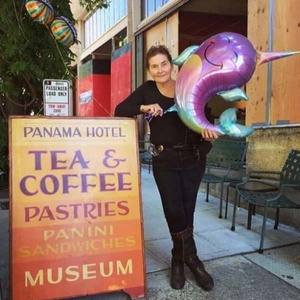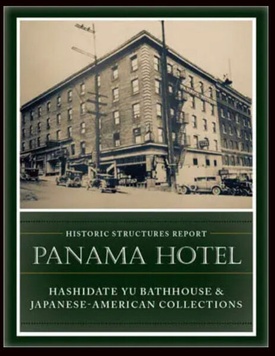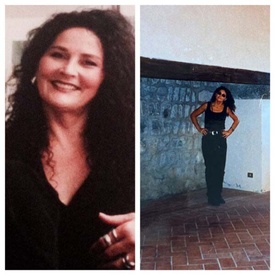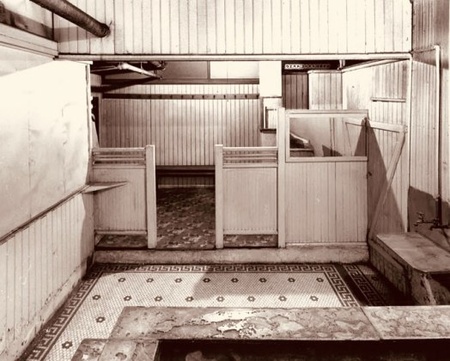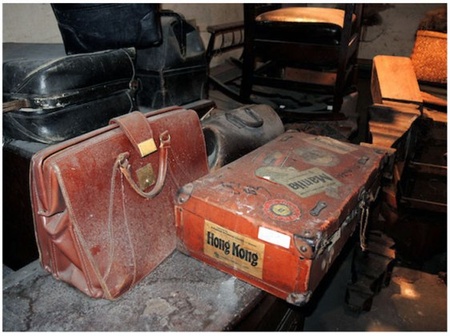Jan Johnson is a well-known name, not just in Seattle but throughout the world. She has welcomed thousands of visitors to the historic Panama Hotel and Tea House in Seattle’s Nihonmachi (Japantown) over the past nearly four decades. On any given day, you can see Jan fixing something in the boiler room, putting a new washer in a sink faucet, running up and down the stairs with a huge bundle of keys jangling from her waist (she knows exactly which ones go to each of the 102 rooms), checking in customers, conducting tours, and saying hello to her customers. But little is known about the woman who single-handedly took over this aging hotel and transformed it into a top destination for visitors around the globe. Jan’s story is one of independence, resourcefulness, and undying love. This interview delves into who she is and how she is helping to write the annals of our living history.
* * * * *
Q: While much has been written about the Panama Hotel, not much is known about you and your background. Can you share with our readers about you and your family roots?
I was born in Olympia, Washington, and after my parents divorced, my father resided in Olympia and my mother lived with her parents in West Seattle. Believe it or not, I do not know exactly what country my grandparents immigrated from in Europe. I do know that my father, Emerald Johnson, was an illegal immigrant, as he appeared to have no “papers” or passports and I was told that we were from a place that had “no boundaries or language.” My mother’s name was Mary Elizabeth Hill Arthur.
Yes, they had many stories, but no country was ever mentioned so I grew up not ever knowing about my family roots. Eventually, my mother remarried. So while I did hear many stories, they were just little fragments of history.
My parents were always working and now I understand why my father always had three jobs. (It was) due to his illegal status.
At around age seven, I would take the Greyhound bus alone from Olympia to my grandparents’ home in West Seattle and I liked to sit next to the bus driver for the best views.
What I remember is that I was drawn to the arts. At the tender age of seven, I would take the bus from West Seattle to downtown and transfer at First and Pike up to Broadway to The Cornish School of Allied Arts. I worked with sculpture, drawings, still life with charcoal, and I continued at Cornish through my school years. My professor kept much of my work.
I learned a lot from my father about carpentry and I especially loved working with natural wood and timbers fresh from the forests. Back then, there was no “babysitting” for kids so I traveled with him on some of his jobs. I remember the delight I had in painting the inside of kitchen cabinets and helping my dad with maintenance projects. So as fate would have it, art and working with my hands became part of my “repertoire.”
Q. So at a young age, you learned about resourcefulness and independence. Where did it take you after you graduated from school?
I didn’t know anything else but hard work. I was always extremely independent and I always worked. My first job was to sell fruit on the Olympia capitol grounds and it was my first introduction to how to make money.
I attended Seattle’s E.C. Hughes Elementary School, Olympia’s Lincoln Elementary School, Denny Junior High, and graduated from both Sealth High School in West Seattle and Olympia High School in Olympia.
I am also a visual person — I have to experience and see. I yearned to experience the arts — “the real thing” — so I wanted to visit Italy. After graduating from high school, I saved money for one-way airfare and I had $25 cash in my pocket when I arrived in Rome. I didn’t tell my mother. The bag checker at the Fiumicino airport in Rome laughed at me as I didn’t understand Italian. My first apartment in Rome overlooked the beautiful Piazza della Rotonda (the Pantheon), but had no heat — b-r-r-r! But I remember that I was continually mesmerized by the color of the light changing in the dome of the Pantheon, depending on the time of day or year.
Prior to going to Italy, I had a memorable experience that ties to Italy. I sailed on an 85-foot schooner in Mexico that was owned by a person named Captain Horace Brown and built in 1934 by Howard Hughes. We celebrated Thanksgiving that year with the family of Dan Lundberg on his boat. I was again treated to the beauty of the gorgeous wood on the boat which, by the way, is what I love about the Panama Hotel.
Years later in Italy, one day while looking for more work, I saw a job announcement for a “marinaio,” which is Italian for a male sailor. They were looking for a boat person. There would never be a female considered for this type of work. It happened to be Lundberg’s boat. I ended up working on the boat and traveled from Italy to Yugoslavia, and then later sailed on more boats in Greece. More gorgeous wood!
I lived in Italy for years, however, I never counted the years or ever referred to a clock or watch to keep track of time. All I remember is that I renewed my passport several times.
I did many things in Italy including helping to design clothing as I also loved working with textiles. Again, it fed my visual and design interests.
Q: So why did you return to Seattle and what did you do?
I vividly remember the devastation from World War II in Europe. I heard constant stories of military regimes, the nightly bombing with red skies burning with fire, hunger, and the ongoing toll on lives. I was ready to return home to Seattle which coincided with my father’s unexpected death around the early 1980s.
My first introduction to the International District was when I stayed in what was the NP Hotel on Sixth Avenue South, right around the corner from the Panama Hotel, which at that time was owned by Takashi Hori and his wife Lily. I was drawn to the neighborhood because the area reminded me of Europe — very active streets with produce and food stands and many small businesses. Mr. Hori purchased the hotel in 1938.
When I first met the Horis, they were most welcoming to me as there were not many Caucasian women living in the neighborhood. And Mrs. Hori sewed! Beautiful fabrics! One day, Mr. Hori was working and showed me the old Japanese “sento” bathhouse in the basement, in the original condition, built at the early turn of the century. I was AMAZED!
And then he showed me the huge amount of personal belongings and trunks in the basement of those Japanese American families who left them when they were forcibly evacuated to the concentration camps during WWII. Maybe I was naive but I couldn’t believe what I saw because I had never learned about the history of WWII. Then when I saw the trunks left behind, I saw the impact of the war here. This all deeply affected me.
* This article was originally published in The North American Post on April 23, 2022.
© 2022 Elaine Ikoma Ko


